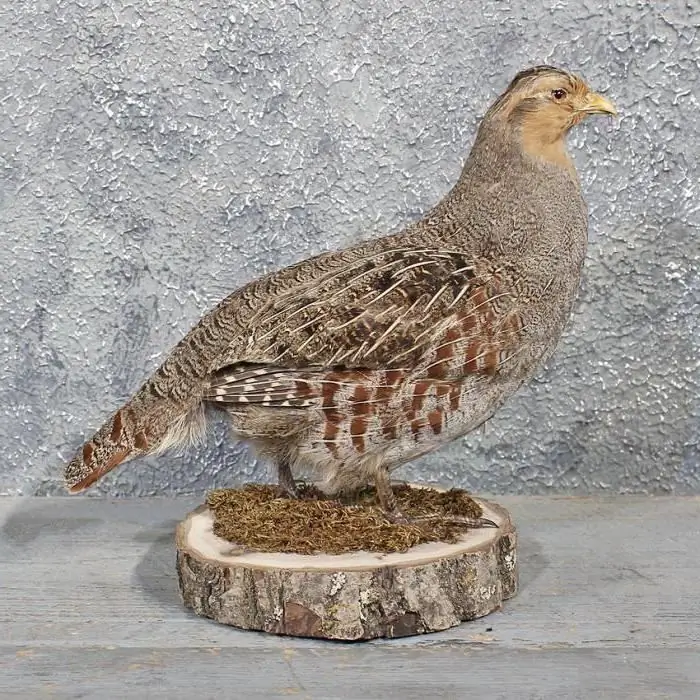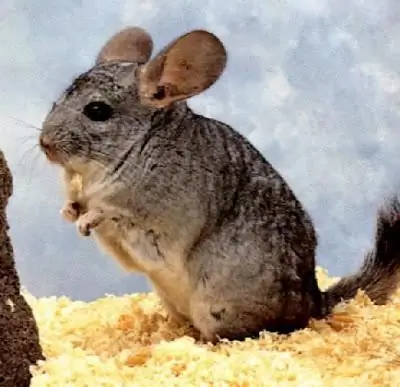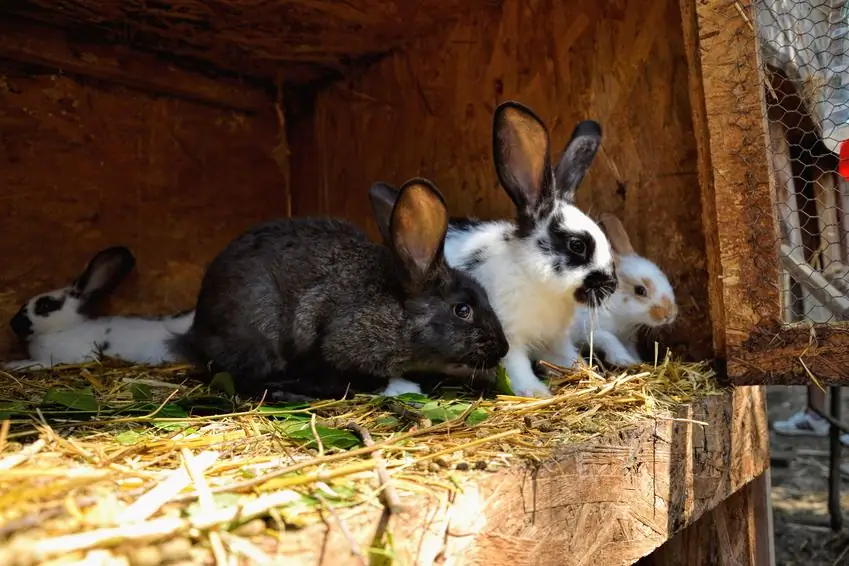2025 Author: Howard Calhoun | [email protected]. Last modified: 2025-06-01 07:12:56
Domestic geese are kept in almost any farmstead. This large loud bird, with undemanding care, is able to provide its "guardians" with meat, fat, as well as feathers and down, traditionally used to stuff featherbeds and pillows.
Large Gray Benefits
Geese occupy a separate niche in all the variety of poultry. Large Ukrainian Gray is a breed whose main factors are:
- possibility of grazing;
- undemanding to the presence of a reservoir;
- excellent maternal performance in females;
- fatty liver capacity (liver weight 350-450 grams);
- rapid growth of offspring (by 9 weeks of age goslings reach a weight of 4.5 kg).
The description of the breeds of geese is almost the same: wide body, neck of medium length, convexchest muscles, massive head. The large gray breed has a red-orange thick beak (pink at the tip), plumage is gray on the back and white on the belly and lower body.

The average weight of a gander is 4-9.5 kg, females - 6-6.5 kg. Average annual egg production: 30-40 pieces with a weight of one egg 160-180 g.
Features of the breed
Grey large goose appeared as a result of crossing breeds such as Roman and Toulouse. It was bred for the purpose of obtaining eggs and meat. This bird leads a flock of life, and relations in the herd are subject to a strict hierarchy. Geese communicate not only with the help of sounds of different volume and frequency. With certain body movements, they signal a danger, which allows the flock to quickly respond to this. Unlike other poultry (chickens, ducks), the large gray goose is able to become attached to the person caring for him.

They are also very touchy and vindictive, so they can take revenge at any opportunity. However, it is worth knowing - without a reason this bird does not rush at anyone. They are not as fussy as ducks and chickens; in the backyard they behave calmly, keep crowded and do not scatter to the sides, they are easy to manage.
Containment conditions
On free grazing, they are able to find their way home on their own, provided that the reservoir is not far from home. In such independence, a certain advantage of geese is observed. Large gray breed is cold-resistant and calmtolerates low temperatures. However, feathered pets need to be provided with a suitable room. Poultry houses adapted for this, under which wooden or adobe structures can be used, must have a floor height of at least 20-30 cm from the ground, in order to avoid dampness. The room should be dry, without drafts, equipped with warm bedding (for one adult head - about 40 kg per year): in winter - from straw or peat, in summer - from sand or sawdust. The danger of damp bedding is that the goose feather gets wet, which will worsen its thermal insulation qualities. In this regard, the bird begins to lose strength, consume more food and catch a cold. It is recommended to treat the litter with superphosphate: per 1 sq. floor meter - 200 g. This operation will not only help to dry it and prevent the release of ammonia, but also to obtain valuable organic fertilizer applied to the soil in early spring.
Feeding the geese
Under the condition of keeping geese in winter, you should take care of preparing enough feed; an adult bird has approximately 10-15 kg of hay (ideally alfalfa or clover) and about 40 kg of root crops (most often carrots). As an additional food, you can prepare branch fodder (from aspen, alder and birch). In winter, such raw materials are steamed and hung low in the house; leaves are ground and mixed into wet food.

In summer, it will be appropriate to harvest water duckweed, which should be dried, and then used as fodderadditive. In the warm period, instead of grass, geese can be fed food waste (especially useful fish) and leftover vegetables. Be sure to have fresh drinking water; in the absence of a natural one, an artificial reservoir will be appropriate (but not necessary for this breed), since swimming is one of the favorite activities for geese.
How to raise geese at home
Feeding of large gray geese is determined by the direction of rearing and seasonality. In spring and summer, bird grazing on natural forage areas will be justified; per day, one individual can eat about 2 kg of grass. As additives, you can feed root crops, cake and bran. The grazing method is successfully used in backyards, because it is low-cost. It is sometimes practiced on large farms with appropriate pastures and water bodies. For grazing geese, it is recommended to select not too wet pastures, because morning dew can be fatal for goslings. It is not recommended to release geese on dirty stagnant water bodies; it is advisable to take care of shelter from the hot rays of the sun in the midday heat.

There is a way of keeping geese, which entails an increase in feeding costs, because the bird does not have the opportunity to freely graze. The advantage of this method is the intensity of fattening due to the calorie content of food and the frequency of its intake, therefore, the most of all, pen keeping, the purpose of which is to obtain high-quality carcasses, is used on specialized breeding or meat farms.
In winterthe bird is given grain mixtures, root crops, hay and silage harvested in the summer. It is advisable to add vitamins to food, the action of which is aimed at normalizing metabolism and optimizing the reproductive properties of the bird's body. A separate necessary component of the winter diet is gravel and chalk, which are poured into separate feeders. In industrial production, a dry type of feeding is used, in which the bird receives a balanced, complete feed.
Hatching eggs: features
The large gray breed of geese has proven itself to be an excellent incubator of eggs. When creating favorable conditions, a goose can bring about 15 he althy chicks in one brood. The incubation period lasts about a month, and it is at this time that the females sitting on the nests should not see each other in order to avoid fights and confusion with perches. Feeding a goose sitting on eggs should be complete: the usual diet should be enriched with yogurt, skim milk and cottage cheese. Otherwise, with a lack of food, the female may peck at the eggs.

The overall fecundity of geese is an order of magnitude lower than that of the rest of poultry: 30-60 eggs per year with a fertility rate of 50-80%. This means that only 5-8 chicks can hatch out of ten eggs. Causes of low fertility in geese:
- Large egg size and resulting scarcity.
- Monogamy of geese, that is, the property to live exclusively in pairs. In a household, there are usually 2-3 geese for one gander. In case of violationBecause of the sex ratio, the gander simply won't be able to fertilize everyone, so some females will remain "single".
- Non-simultaneous maturation of females and males. The goose may start laying eggs in early spring, but the gander is not yet ready to mate.
Large gray geese are caring parents
The large gray goose starts to rush when the daylight hours are 12-14 hours, this is March-April. An important condition during this period is the temperature in the house, which should not be lower than 12-14 degrees. Usually the female rushes every other day, therefore, in order to simultaneously hatch the chicks, the eggs need to be collected, after which everything should be placed under the goose or in the incubator. The shelf life of the collected eggs is no more than 7-10 days. The incubation period is 28-30 days.

An excellent mother will be a hen who sits on the nest all the time, almost without getting up. A large gray breed of geese has all the qualities of a caring parent, so maternal care for goslings will be quite enough. The puberty of a large gray goose occurs later than that of the rest of poultry: at 7-12 months, with intensive cultivation - at half a year. The age of the bird also affects fertility: at 3-4 years it reaches its maximum, after which it sharply declines.
Raising young animals
How to grow geese at home? Hatched babies in the first days are fed with a mixture of cottage cheese or hard-boiled eggs, crushed corn or wheat, mixed with soybean or sunflower meal. After 4-5 days you cangradually give cake and root crops. Food for goslings should be in the form of wet mash: it is easily digestible and does not clog the nasal openings.
Young animals intended for growing for meat are recommended to be kept in a paddock (without the possibility of walking) and fed with concentrates with the addition of greens. It is this method of keeping that will determine the achievement of a weight of 4-4.5 kg by 9-10 weeks - the moment of slaughter. Intensive growth in goslings occurs in the first two months; it is at this time that 2-2.5 kg of grain and up to 9 kg of succulent feed are consumed per 1 kg of bird weight. Further keeping of the bird makes sense in order to reproduce the herd, because as the growth rate decreases, fat deposition begins, and hemp appears on the carcass.
Pride of Breeders
The large gray goose, despite its low fecundity, is the fastest growing bird. It achieves a record weight in a short time, and this happens at minimal cost.

That is why large gray geese, reviews of which are only positive, are successfully used by breeders for crossing with other breeds. This is done in order to obtain high-quality hybrid offspring.
Recommended:
Raising a calf: methods, tips for breeding and keeping. Diet of calves, characteristics and features of breeds

Now more and more people leave the big cities and go to the outback. The settlers want to engage in agriculture, but they still do not know how to do much. For example, it is not uncommon when a cow gave birth, and the owner does not know what to do with the offspring. Calves are raised by different methods, but in order to choose the best method for yourself, it is better to familiarize yourself with all existing
Partridges: breeding and keeping at home. Breeding and keeping partridges at home as a business

Breeding partridges at home as a business is a wonderful idea, because so far it is exotic to some extent, does not require significant investments at the start (or even none at all), there is no special knowledge for growing an unpretentious and little sick bird need. And demand today exceeds supply. This business can be especially interesting in small towns and villages where there are problems with employment and other types of earnings
Chinchilla breeding as a business: growing, keeping, breeding at home

Our planet has long been inhabited by thousands of species of living beings and plants, many of which are still not studied or poorly studied. Species that have gained particular popularity among humans are listed in the Red Book
Rabbits of the Strokach breed: description of the species, features of care, reproduction, characteristic features of the breed and rules of keeping

If someone has a goal to breed rabbits of the Strokach breed, then it is necessary to remember that it is best to have only the strongest and best individuals of the German breed. When grown at home, many farmers do not always succeed in breeding a pure breed, as some individuals are variegated or get sick
Chinese silk chicken: description and characteristics of the breed, keeping and breeding

Often, in the farms of amateur poultry farmers, you can meet a completely amazing, even unique bird. It is about this breed of chickens - Chinese silk, that we want to talk about today. What is their uniqueness, how do they differ from other birds? This will be discussed in this article

